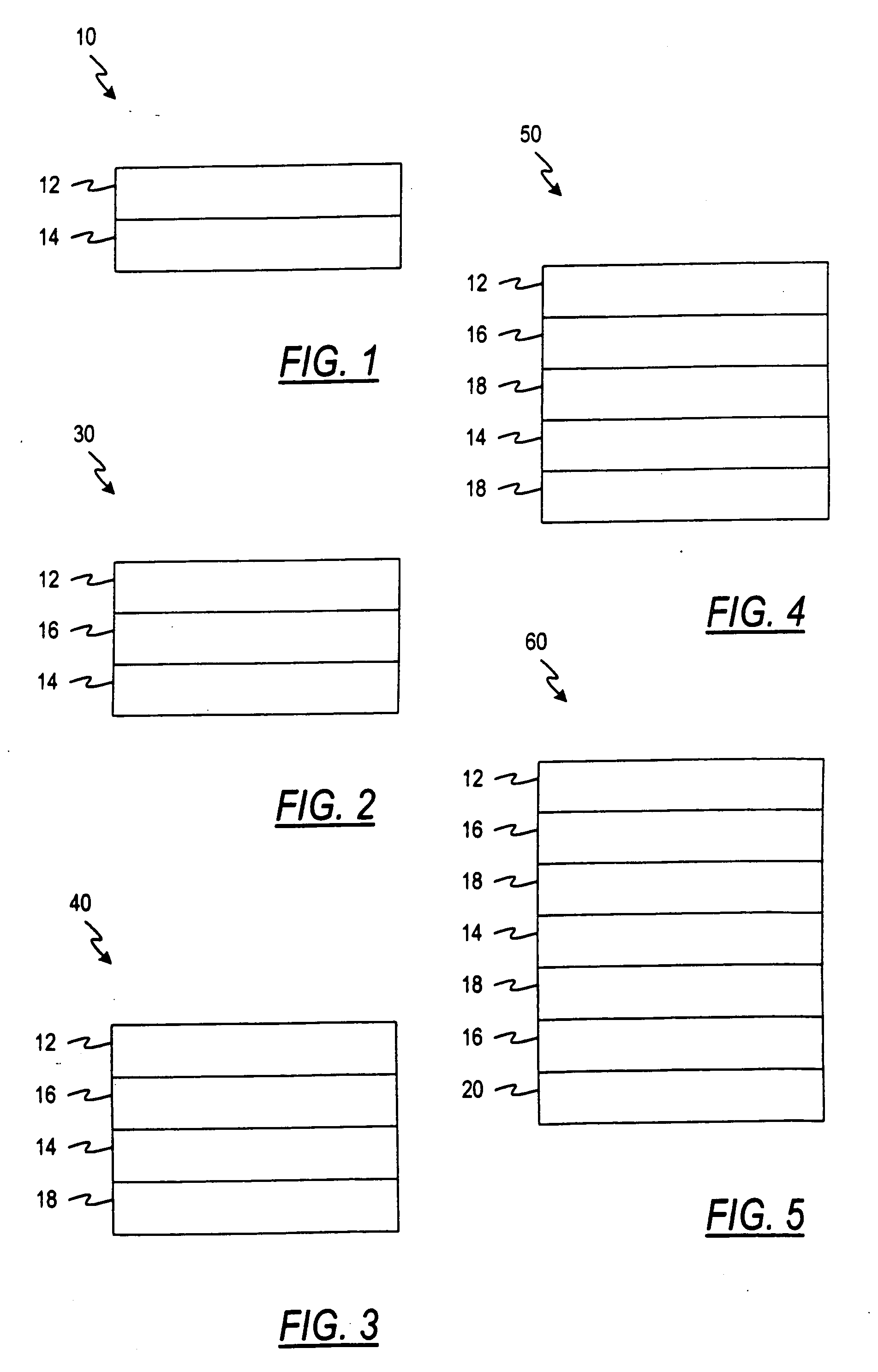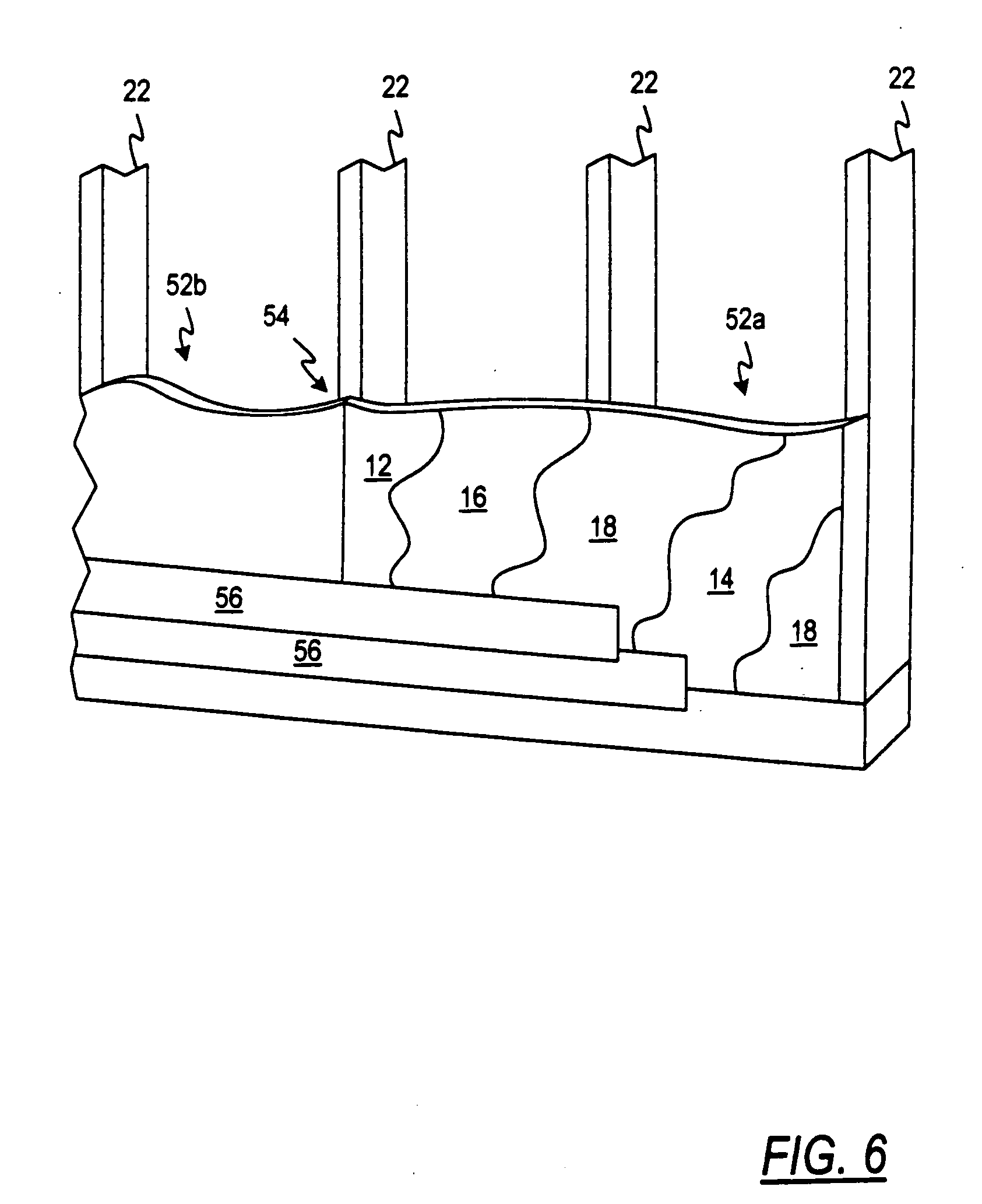Polymeric foam scrim sheathings
- Summary
- Abstract
- Description
- Claims
- Application Information
AI Technical Summary
Benefits of technology
Problems solved by technology
Method used
Image
Examples
example 1
[0059] Negative wind pressure load tests were conducted on samples of sheathing (“Sheathing 1”) using a 2×4 (1½ inches×3½ inches) stud as a wall supporting structure. Sheathing 1 had dimensions of 48 inches by 90 inches (48″×90″). Sheathing 1 consisted of five layers with the first layer being a woven polypropylene scrim with a selvage tack. The second layer was made of a BYNEL® adhesive. The third and fifth layers were made of high impact polystyrene. The second layer was located between the first and third layers. The fourth layer was a polystyrene foam and was located between the third and fifth layers. This is a similar structure as shown above in FIG. 4. The following describes the test specimens that were used in Example 1.
[0060] Example 1 Specimen Description
[0061] A. Materials [0062] 1. Stud: 2×4, Stud Grade spruce pine fur (SPF) spaced at 16″ on center (o.c.) [0063] 2. Top Plate: Single 1×4, Ungraded SPF [0064] 3. Bottom Plate: Single 1×4, Ungraded SPF [0065] 4. Gypsum: 5...
example 2
[0084] Negative wind pressure load tests were conducted on samples of 48″×90″ Sheathing 1 (described above in Example 1) without a selvage tuck on the scrim layer using a 2×4 stud as a wall supporting structure. The following describes the test specimens that were used in Example 2.
[0085] Example 2 Specimen Description
[0086] A. Materials [0087] 1. Stud: 2×4, Stud Grade SPF spaced at 16″ (o.c.) [0088] 2. Top Plate: Single 1×4, Ungraded SPF [0089] 3. Bottom Plate: Single 1×4, Ungraded SPF [0090] 4. Gypsum: 5 / 16″ U.S. Gypsum [0091] 5. Siding: Georgia Pacific Parkside® D5 Vinyl Siding with a nailing flange thickness of 0.038 inch.
[0092] B. Fastening [0093] Top plate attached to studs with five (5)— 7 / 16″×1¾″×16 Ga. Staples. [0094] Bottom plate attached to studs with five (5)— 7 / 16″×1¾″×16 Ga. Staples. [0095] Sheathing 1 fastened with 1″×1½″×16 Ga. staples at 3″ o.c. around perimeter and 3″ o.c. in the field. [0096] Gypsum glued to frame with a ⅜″ bead of PVA glue on all framing membe...
example 3
[0105] Negative wind pressure load tests were conducted on samples of 48″×90″ Sheathing 1 (described above in Example 1) without a selvage tuck on the scrim layer using a 2×6 stud as a wall supporting structure. The following describes the test specimens that were used in Example 3.
[0106] Example 3 Test Specimen Description
[0107] A. Materials [0108] 1. Wall Stud: 2×6, Stud Grade SPF spaced at 16″ (o.c.) [0109] 2. Top Plate: Single 1×6, Ungraded SPF [0110] 3. Bottom Plate: Single 1×6, Ungraded SPF [0111] 4. Siding: Georgia Pacific Parkside® D5 Vinyl Siding with a nailing flange thickness of 0.038 inch.
[0112] B. Fastening [0113] Top plate attached to studs with five (5)— 7 / 16″×1¾″×16 Ga. Staples. [0114] Bottom plate attached to studs with five (5)— 7 / 16″×1¾″×16 Ga. Staples. [0115] Adhesive—Not used [0116] Gypsum—Not used [0117] Sheathing 1 fastened with 1″×1¼″×16 Ga. Staples, Angled at 45 degrees at 3″ o.c. in the field and 3″ o.c. around perimeter. [0118] Siding fastened to sheath...
PUM
| Property | Measurement | Unit |
|---|---|---|
| Length | aaaaa | aaaaa |
| Thickness | aaaaa | aaaaa |
| Thickness | aaaaa | aaaaa |
Abstract
Description
Claims
Application Information
 Login to View More
Login to View More - R&D Engineer
- R&D Manager
- IP Professional
- Industry Leading Data Capabilities
- Powerful AI technology
- Patent DNA Extraction
Browse by: Latest US Patents, China's latest patents, Technical Efficacy Thesaurus, Application Domain, Technology Topic, Popular Technical Reports.
© 2024 PatSnap. All rights reserved.Legal|Privacy policy|Modern Slavery Act Transparency Statement|Sitemap|About US| Contact US: help@patsnap.com










